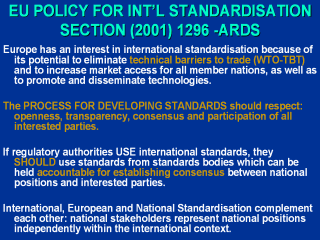| front |1 |2 |3 |4 |5 |6 |7 |8 |9 |10 |11 |12 |13 |14 |15 |16 |17 |18 |19 |20 |21 |22 |23 |24 |25 |26 |27 |28 |29 |30 |31 |32 |33 |34 |35 |36 |37 |38 |39 |40 |41 |42 |43 |44 |45 |46 |47 |48 |49 |50 |51 |52 |53| 54 |55 |56 |57 |review |
 |
The EU Commission was asked by
the Council to develop Guidelines for a European Standardisation Policy in tStandardisation in Europe is based on the principle of national representation. Therefore, it is primarily the task of the national members of the ESOs to ensure that all relevant, interested parties have the opportunity to contribute to the development of European standards IV. To have one applied standard and one accepted test for each product, process or service is a trade-facilitating objective. International standards have a maximum effect in trade facilitation when they are part of a single and coherent set of standards. If international standards are used in relation to technical regulations as promoted by the WTO TBT Agreement, international standards bodies need to have a clearly defined constituency. The relevant WTO principles taken as a whole ensure that international standards bodies are open to participation by national standards bodies and produce international standards that do not conflict with each other. V. The voluntary use of standards in regulation requires a clear definition of each party’s roles and competencies. Voluntary standards can nevertheless reduce the need for regulation, respectively government intervention. VI. Measures to improve efficiency of international standards bodies should further be deployed. Striving for more efficiency should not conflict with accountability. VII. It may be beneficial to channel standards, specifications and other deliverables into the international standardisation process that have reached a certain consensus outside international standards bodies. Co-operative arrangements with international standards bodies offer a systematic framework to take over international standards and/or to contribute to the international standards making process. The Vienna and Dresden Agreements between ISO and CEN, respectively the IEC and CENELEC are useful examples how to enable for input, to avoid double work or to speed up standardisation work. In this regard, it is important to ensure that the maintenance of the international standard is considered first with the international standards body who may decide whether or not to delegate the maintenance responsibility to the originating body. 1. Standards significantly matter to enterprises, consumers and governments. For businesses standards help to create a common trading language. They ensure that parts produced across borders are compatible and that networks are interoperable, they reduce costs for manufacturing and warehousing. For consumers, standards reduce the costs they generally face when deciding for options, such as time and efforts they devote to their search. Standards generally reduce the costs of uncertainty, in particular when relating to functional properties as they facilitate comparisons. For governments, standards offer an opportunity for deregulation and improved governance as they help to reduce the level of regulatory detail to the essential requirements needed to attain legitimate objectives such as the protection of health, safety and the environment. Standards help to reduce the risk of being locked into a specific technology and promote the dissemination of know-how. 2. Increased trade is linked with economic development and, in many ways, leads to more convergence between trading partners. Had it not been for its capacity to facilitate exchange and access to markets, to improve the quality and safety of products and services, and to disseminate knowledge, technology and business practices, standardisation would not have become a crucial element in European economic integration and world trade. Beyond the role standards play for the functioning of the internal market and for contributing to the protection of public interest, they are also an important element in the Community’s enlargement process and in external trade agreements. 3. Standardisation is a voluntary process and for no matter which subject, this process has to be open and transparent, and result in a consensus amongst stakeholders. International standardisation is carried out by a number of societal stakeholders who reconcile their positions nationally and internationally. 4. But to reap the full benefits of international standardisation, it is important to take some basic requirements into account and to balance the interests not only of industry, but also consumer concerns, health and safety considerations, environment aspects and concerns of small and medium sized enterprises (SMEs). It may also be beneficial to consider the interface of standards and regulations, respectively the scope for standardisation and regulatory activity and the procedures chosen to demonstrate conformity with legal requirements and/or standards. 5. In addition, these principles ensure, among other aspects, that all interested parties can participate in the work and that standards neither impede competition, nor hinder progress and technological innovation. European stakeholders also strive for coherent standards, preferably one standard, based on the international one. |